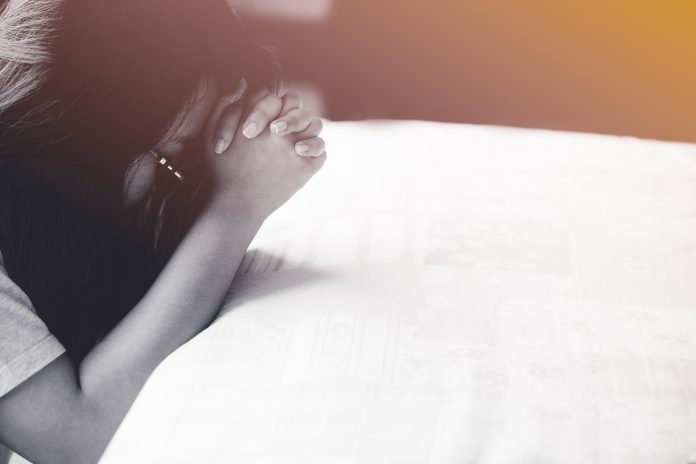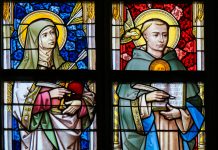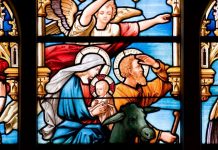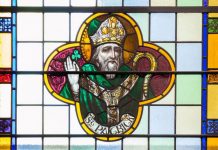
by Kate Ristow
[CLICK HERE] for a worksheet that students can complete as you present each of the Triduum liturgies.
The Catechism of the Catholic Church calls the Easter Triduum the “source of light” for the whole liturgical year (n. 1168). In the Triduum—the culmination of the Church year—we celebrate the Passion, Death, and Resurrection of the Lord. The liturgies of these days are filled with signs, symbols, words, movement, gestures, and sounds that draw us into the Paschal Mystery. We do more than simply recall and celebrate the saving events that happened 2,000 years ago. In the unfolding of these three sacred days, the dying and rising of Christ is made truly present—today, in the here and now.
The Depth and Breadth of the Triduum
Although the Triduum takes place over three days—counting from sundown to sundown, according to Jewish tradition, from Holy Thursday night to Easter Sunday evening—help your students begin to grasp that the Triduum is one three-day, continuous celebration. Unless we see these days as an organic whole, we miss their interconnectedness.
The institution of the Eucharist on Holy Thursday gives deeper meaning to the bread and wine shared by the neophytes for the first time at the Easter Vigil and our reception of Holy Communion during the liturgy. Our sorrow at Jesus’ death on Good Friday turns to joy when we celebrate his rising on Saturday night. Make these connections! We are an Easter people. Christ’s suffering and death has no meaning without his Resurrection to new life.
The Triduum, Day by Day
Do your best to devote a full class session to the Triduum. We need to teach about it and, hopefully, prepare our students to participate in the liturgies of these days. True, the reality is that the majority of kids never see the inside of the church during the Triduum, although Easter Sunday is usually very well-attended. But think of it this way: What the kids learn in your session might trigger a desire within them to ask their parents to take them to the Holy Thursday, Good Friday, or Easter Vigil liturgy. Do not brush this off as a fruitless effort; think of yourself as a missionary. Inviting your students to be part of the Triduum by learning about it is the New Evangelization at its best!
ACTIVITY: Gather the children around a large calendar. Have them find the date of Easter this year. Point out the date for Holy Thursday, or the Evening Mass of the Lord’s Supper. Point out the date of Good Friday, or Good Friday of the Lord’s Passion. Finally, point out the date of Holy Saturday, when we celebrate the Easter Vigil. Tell students they will learn about each of these liturgies in today’s session.
ACTIVITY: Have students work in pairs and challenge them to create a text message on paper that the parish might send out, inviting families to celebrate the Triduum by attending the liturgies at church. Afterward, invite volunteers to share their texts with the class.
Holy Thursday: Evening Mass of the Lord’s Supper: During the Holy Thursday liturgy, we notice that white vestments have replaced the somber violet garb of Lent. We praise the Lord by singing the Gloria for the first time in six long weeks. We announce our great joy with singing and the ringing of bells (inside and outside the church)—hand bells, the sanctus bells, and even bells brought from home by parishioners. At the Easter Vigil, we will again joyfully sing the Gloria and ring bells.
We reenact Jesus’ washing of the feet (John 13:1-15). We call this the Mandatum—Jesus’ command to love and serve others. Jesus humbly washed the feet of the Apostles as an example of how his followers are to act. We remember that Jesus’ greatest act of service was his death on the cross.
Later in the liturgy, we remember Jesus’ gift of the Eucharist at the Last Supper. Extra hosts are consecrated for Communion the next day because Mass is not celebrated on Good Friday.
At the end of Mass, the Blessed Sacrament is incensed and then carried to an altar of repose. A time of silent adoration follows. The main altar is stripped. Crosses are covered. Candles are extinguished. With no formal dismissal, we leave church in silence. Many remain in church, however, to keep watch with Christ.
ACTIVITY: Show students a handful of incense grains. Recall that incense—frankincense—was one of the gifts presented to the infant Jesus by the magi at his birth. Explain that incense is burned as a sign of adoration, honor, and purification. When we use incense in prayer, we ask that our prayers rise to God as the aroma and smoke rise, and that the Lord’s mercy and blessings will descend upon us in response to our prayers. During your closing prayer, light the incense. Have students raise their arms overhead and repeat, “May our prayers rise to heaven, O Lord!”
ACTIVITY: Work with other catechists to organize a Christian Seder meal before Holy Week. Adults and kids will enjoy the ritual, and it will encourage families to participate in the celebration of the Evening Mass of the Lord’s Supper. Do an internet search using the words “Christian Family Seder Meal.” You will find many options to choose from. Select the format that best meets your needs or combine different elements from several sources.
Good Friday: Friday of the Passion of the Lord: Just as last night’s liturgy ended without a dismissal, this service begins without a greeting and so highlights the fact that our worship during these sacred days is continuous; the Triduum is a single, three-day celebration. The atmosphere is somber; the church is bare. We come together to meditate on Christ’s self-giving love.
Upon entering in red vestments, the priest and deacon prostrate themselves, or lay face down, on the altar in silence. The assembly kneels. The priest then stands and prays.
The Passion from John’s Gospel is read. We pray the Prayers of the Faithful in a new way, standing as each petition is read and kneeling in silent prayer after each one.
The two major parts of the Good Friday liturgy are the Veneration of the Cross and Holy Communion. Holding the cross for all to see, the priest proclaims, “This is the wood of the cross” three times. We respond, “Come, let us worship.” We then come forward individually to venerate, or show our reverence, for the cross. We may kiss it, bow or genuflect before it, or simply touch it respectfully with our hand.
Holy Communion follows, using the hosts consecrated during yesterday’s service. We pray the Lord’s Prayer together and then receive the Eucharist in memory of Jesus.
Following the Prayer after Communion, we again depart in silence as we did the night before.
ACTIVITY: Discuss with the class what purpose it serves for the altar to be stripped following the Holy Thursday liturgy so that the church is bare on Good Friday. Help students understand that this allows us to focus on Jesus’ sacrifice without distraction.
ACTIVITY: If time permits, have older students work in small groups to compare and contrast the different Gospel accounts of Christ’s passion and death. List the references on the board: Matthew 26:36—27; Mark 14:32—15:42; Luke 22:39—23; and John 18:1—19:42. In order for the kids to benefit from this activity, they will need time. Consider setting aside time in two or three classes during the last weeks of Lent for this activity.
Holy Saturday: The Easter Vigil: The Easter Vigil has four parts.
The Service of Light: The new paschal candle is lit from a large fire burning outside the church. The paschal candle is carried through the church in procession as the priest or deacon, wearing white or gold vestments, proclaims three times, “Christ our light!” We respond, “Thanks be to God” as our individual candles are lit and the church fills with light. The paschal candle is placed next to the ambo where it remains during the 50 days of the Easter Season.
The Liturgy of the Word: The nine readings include seven readings from the Old Testament, beginning with the story of the Creation of the world, and conclude with the Gospel, which is one of the accounts of Jesus’ Resurrection. (The hymn Gloria in excelsis Deo is intoned between the readings from the Old Testament and the New Testament.) These readings tell the story of our relationship with God; they proclaim how God prepared the way for Jesus, our light. They are the history of our salvation through Jesus Christ.
The Liturgy of Baptism: During this exciting part of the Vigil, we welcome new members to the Catholic Church and our community. Guided by the Rite of Christian Initiation of Adults, we baptize the elect—individuals who have never been baptized before in another faith. They are each given a white garment and a candle—the light of Christ. They are then confirmed, along with candidates who have been previously baptized into another Christian faith. Then the candles of everyone in the assembly are relit. We renew our baptismal promises together and are blessed with holy water.
The Liturgy of the Eucharist: The entire Vigil leads to the celebration of the Eucharist. Those newly confirmed will receive this, the final Sacrament of Christian Initiation. We have celebrated the Light of Christ in the world; we have been nourished by God’s Word; we have reaffirmed our Baptism. We now give thanks and praise for the Body and Blood of Christ which gives us everlasting life.
ACTIVITY: Gather the children around the prayer table on which you have placed a glass bowl of holy water. Remind the students that we renew our baptismal promises at the Easter Vigil. Explain that another way in which we can profess our faith is by praying the Apostles’ Creed. Pray the Creed together, permitting the children to use their texts if necessary. Conclude with a moment of silence. Then invite students to show their belief in all they have prayed by signing themselves with holy water.
ACTIVITY Divide students into three groups and assign one of the Triduum liturgies to each group. Distribute to each group a large panel of butcher or shelf paper that you cut before class. Encourage students to title their panel and to use illustrations and words to indicate what happens during their celebration. Post the completed panels in a public area of the parish for all to see.
As you conclude your lesson, share with your students the Entrance Antiphon for the Evening Mass of the Lord’s Supper on Holy Thursdaym which is based on Galatians 6:14. These words point the way to understanding what the Paschal Triduum is and what happens during the liturgies: It’s all about the salvation Jesus won for us. Have students repeat each line of the passage with you before you send them on their way:
“We should glory in the cross of our Lord Jesus Christ, in whom is our salvation,
life and resurrection, through whom we are saved and delivered.”
Kate Ristow, Contributing Editor to CATECHIST, has worked in Catholic publishing for over 25 years as a national speaker and writer, building on a wealth of experience in the religious formation of children and catechists in both parish and Catholic school programs.
Copyright 2013, Bayard, Inc. All rights reserved. This article is protected by United States copyright and other intellectual property laws and may not be reproduced, rewritten, distributed, redisseminated, transmitted, displayed, published or broadcast, directly or indirectly, in any medium without the prior written permission of Bayard, Inc.
This article was written by the Catechist Staff and appeared in Catechist magazine, June 2013.
Image Credit: MIA Studio/Shutter Stock 557176453




